Reducing Food Waste: Recommendations and Strategies for Sustainability
VerifiedAdded on 2023/06/05
|5
|1369
|112
Report
AI Summary
This report provides a detailed analysis of food waste reduction strategies. It emphasizes the importance of planning, including meal planning and shopping lists, to avoid overbuying and impulse purchases. The report highlights storage techniques, such as proper refrigeration and freezing, to prevent food spoilage. It also covers food preparation methods, like cooking perishable items and utilizing all edible parts of food commodities. The report analyzes data showing that individuals often order and purchase more food than they need, leading to significant waste. The conclusion emphasizes that the implementation of these recommendations leads to a reduction in food spoilage and, consequently, less food waste, promoting environmental sustainability and saving money.
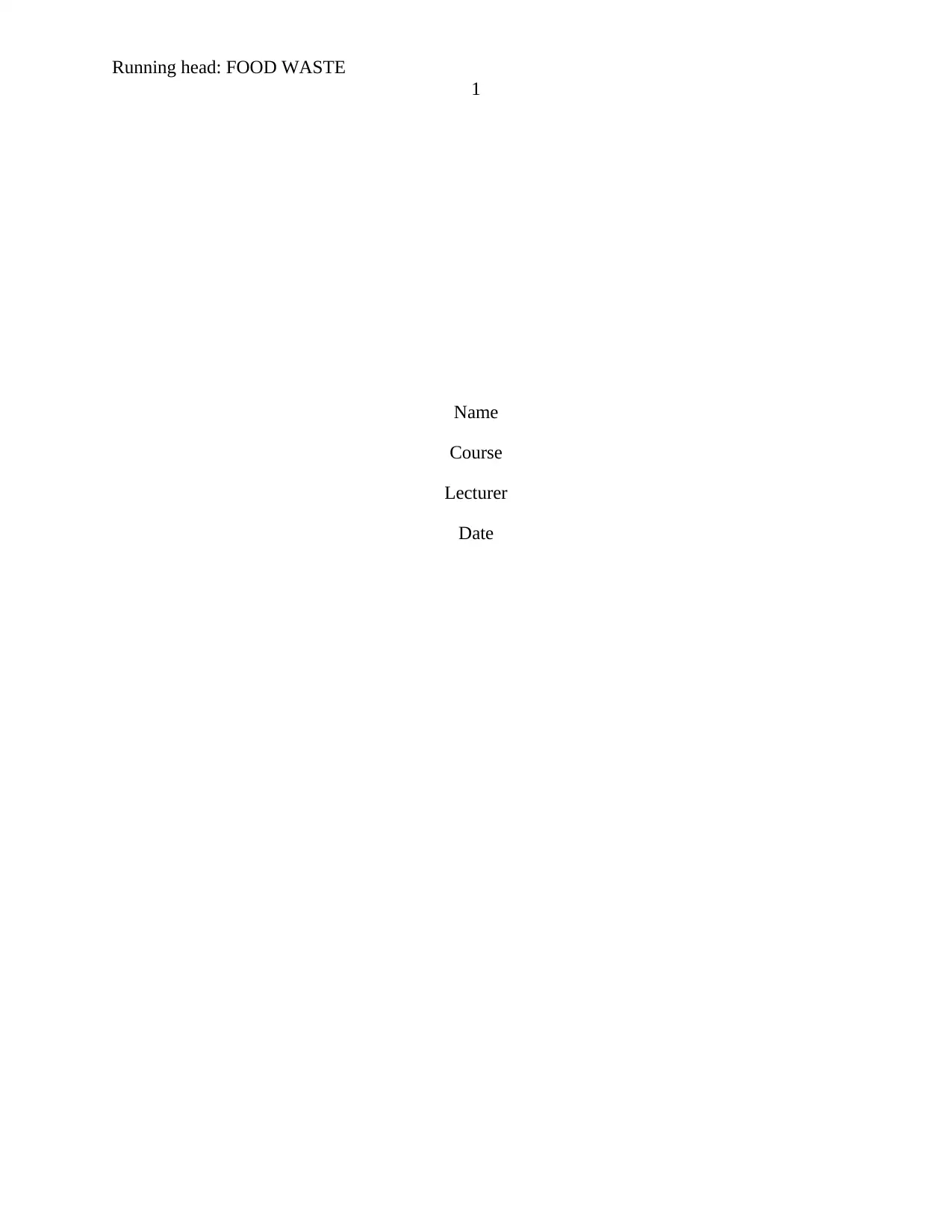
Running head: FOOD WASTE
1
Name
Course
Lecturer
Date
1
Name
Course
Lecturer
Date
Paraphrase This Document
Need a fresh take? Get an instant paraphrase of this document with our AI Paraphraser
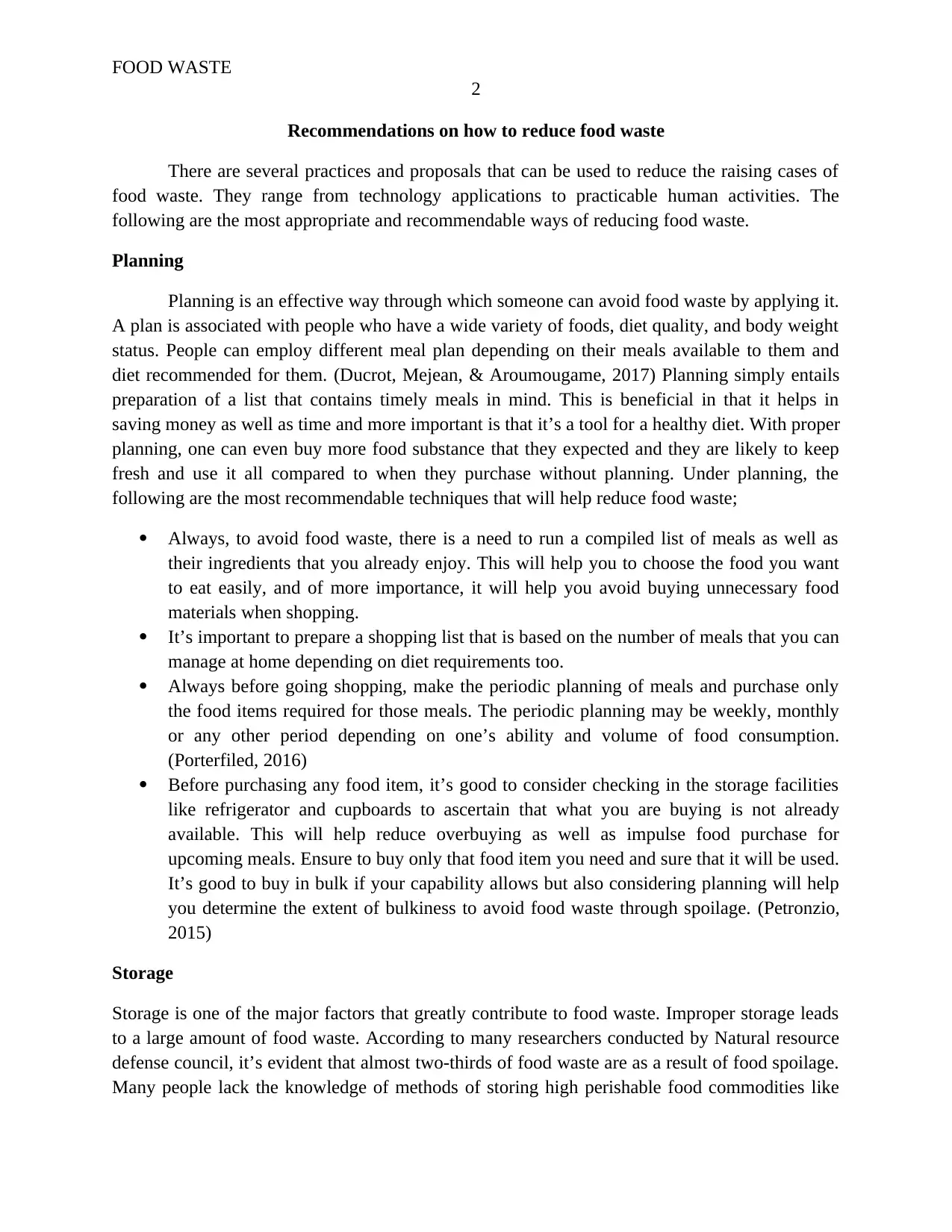
FOOD WASTE
2
Recommendations on how to reduce food waste
There are several practices and proposals that can be used to reduce the raising cases of
food waste. They range from technology applications to practicable human activities. The
following are the most appropriate and recommendable ways of reducing food waste.
Planning
Planning is an effective way through which someone can avoid food waste by applying it.
A plan is associated with people who have a wide variety of foods, diet quality, and body weight
status. People can employ different meal plan depending on their meals available to them and
diet recommended for them. (Ducrot, Mejean, & Aroumougame, 2017) Planning simply entails
preparation of a list that contains timely meals in mind. This is beneficial in that it helps in
saving money as well as time and more important is that it’s a tool for a healthy diet. With proper
planning, one can even buy more food substance that they expected and they are likely to keep
fresh and use it all compared to when they purchase without planning. Under planning, the
following are the most recommendable techniques that will help reduce food waste;
Always, to avoid food waste, there is a need to run a compiled list of meals as well as
their ingredients that you already enjoy. This will help you to choose the food you want
to eat easily, and of more importance, it will help you avoid buying unnecessary food
materials when shopping.
It’s important to prepare a shopping list that is based on the number of meals that you can
manage at home depending on diet requirements too.
Always before going shopping, make the periodic planning of meals and purchase only
the food items required for those meals. The periodic planning may be weekly, monthly
or any other period depending on one’s ability and volume of food consumption.
(Porterfiled, 2016)
Before purchasing any food item, it’s good to consider checking in the storage facilities
like refrigerator and cupboards to ascertain that what you are buying is not already
available. This will help reduce overbuying as well as impulse food purchase for
upcoming meals. Ensure to buy only that food item you need and sure that it will be used.
It’s good to buy in bulk if your capability allows but also considering planning will help
you determine the extent of bulkiness to avoid food waste through spoilage. (Petronzio,
2015)
Storage
Storage is one of the major factors that greatly contribute to food waste. Improper storage leads
to a large amount of food waste. According to many researchers conducted by Natural resource
defense council, it’s evident that almost two-thirds of food waste are as a result of food spoilage.
Many people lack the knowledge of methods of storing high perishable food commodities like
2
Recommendations on how to reduce food waste
There are several practices and proposals that can be used to reduce the raising cases of
food waste. They range from technology applications to practicable human activities. The
following are the most appropriate and recommendable ways of reducing food waste.
Planning
Planning is an effective way through which someone can avoid food waste by applying it.
A plan is associated with people who have a wide variety of foods, diet quality, and body weight
status. People can employ different meal plan depending on their meals available to them and
diet recommended for them. (Ducrot, Mejean, & Aroumougame, 2017) Planning simply entails
preparation of a list that contains timely meals in mind. This is beneficial in that it helps in
saving money as well as time and more important is that it’s a tool for a healthy diet. With proper
planning, one can even buy more food substance that they expected and they are likely to keep
fresh and use it all compared to when they purchase without planning. Under planning, the
following are the most recommendable techniques that will help reduce food waste;
Always, to avoid food waste, there is a need to run a compiled list of meals as well as
their ingredients that you already enjoy. This will help you to choose the food you want
to eat easily, and of more importance, it will help you avoid buying unnecessary food
materials when shopping.
It’s important to prepare a shopping list that is based on the number of meals that you can
manage at home depending on diet requirements too.
Always before going shopping, make the periodic planning of meals and purchase only
the food items required for those meals. The periodic planning may be weekly, monthly
or any other period depending on one’s ability and volume of food consumption.
(Porterfiled, 2016)
Before purchasing any food item, it’s good to consider checking in the storage facilities
like refrigerator and cupboards to ascertain that what you are buying is not already
available. This will help reduce overbuying as well as impulse food purchase for
upcoming meals. Ensure to buy only that food item you need and sure that it will be used.
It’s good to buy in bulk if your capability allows but also considering planning will help
you determine the extent of bulkiness to avoid food waste through spoilage. (Petronzio,
2015)
Storage
Storage is one of the major factors that greatly contribute to food waste. Improper storage leads
to a large amount of food waste. According to many researchers conducted by Natural resource
defense council, it’s evident that almost two-thirds of food waste are as a result of food spoilage.
Many people lack the knowledge of methods of storing high perishable food commodities like
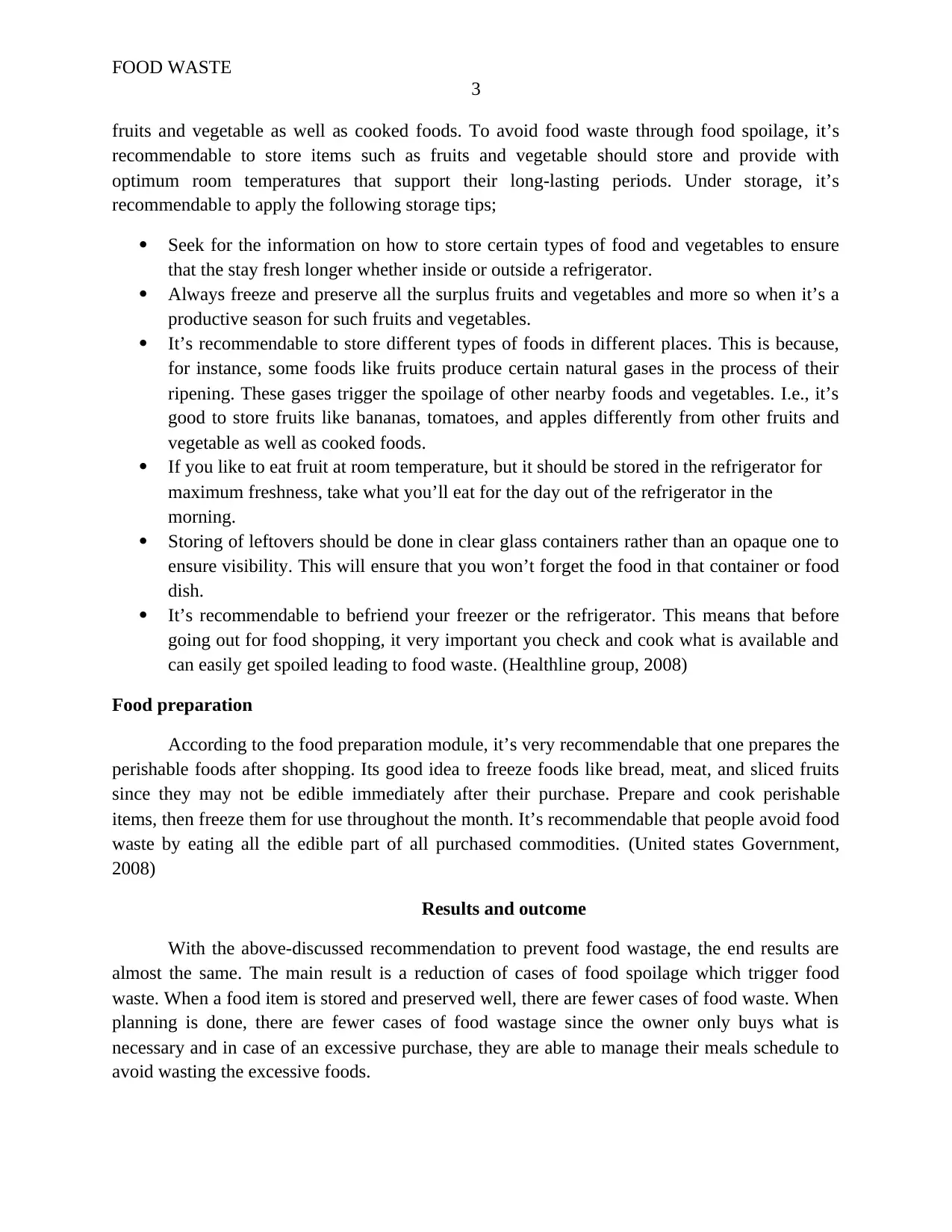
FOOD WASTE
3
fruits and vegetable as well as cooked foods. To avoid food waste through food spoilage, it’s
recommendable to store items such as fruits and vegetable should store and provide with
optimum room temperatures that support their long-lasting periods. Under storage, it’s
recommendable to apply the following storage tips;
Seek for the information on how to store certain types of food and vegetables to ensure
that the stay fresh longer whether inside or outside a refrigerator.
Always freeze and preserve all the surplus fruits and vegetables and more so when it’s a
productive season for such fruits and vegetables.
It’s recommendable to store different types of foods in different places. This is because,
for instance, some foods like fruits produce certain natural gases in the process of their
ripening. These gases trigger the spoilage of other nearby foods and vegetables. I.e., it’s
good to store fruits like bananas, tomatoes, and apples differently from other fruits and
vegetable as well as cooked foods.
If you like to eat fruit at room temperature, but it should be stored in the refrigerator for
maximum freshness, take what you’ll eat for the day out of the refrigerator in the
morning.
Storing of leftovers should be done in clear glass containers rather than an opaque one to
ensure visibility. This will ensure that you won’t forget the food in that container or food
dish.
It’s recommendable to befriend your freezer or the refrigerator. This means that before
going out for food shopping, it very important you check and cook what is available and
can easily get spoiled leading to food waste. (Healthline group, 2008)
Food preparation
According to the food preparation module, it’s very recommendable that one prepares the
perishable foods after shopping. Its good idea to freeze foods like bread, meat, and sliced fruits
since they may not be edible immediately after their purchase. Prepare and cook perishable
items, then freeze them for use throughout the month. It’s recommendable that people avoid food
waste by eating all the edible part of all purchased commodities. (United states Government,
2008)
Results and outcome
With the above-discussed recommendation to prevent food wastage, the end results are
almost the same. The main result is a reduction of cases of food spoilage which trigger food
waste. When a food item is stored and preserved well, there are fewer cases of food waste. When
planning is done, there are fewer cases of food wastage since the owner only buys what is
necessary and in case of an excessive purchase, they are able to manage their meals schedule to
avoid wasting the excessive foods.
3
fruits and vegetable as well as cooked foods. To avoid food waste through food spoilage, it’s
recommendable to store items such as fruits and vegetable should store and provide with
optimum room temperatures that support their long-lasting periods. Under storage, it’s
recommendable to apply the following storage tips;
Seek for the information on how to store certain types of food and vegetables to ensure
that the stay fresh longer whether inside or outside a refrigerator.
Always freeze and preserve all the surplus fruits and vegetables and more so when it’s a
productive season for such fruits and vegetables.
It’s recommendable to store different types of foods in different places. This is because,
for instance, some foods like fruits produce certain natural gases in the process of their
ripening. These gases trigger the spoilage of other nearby foods and vegetables. I.e., it’s
good to store fruits like bananas, tomatoes, and apples differently from other fruits and
vegetable as well as cooked foods.
If you like to eat fruit at room temperature, but it should be stored in the refrigerator for
maximum freshness, take what you’ll eat for the day out of the refrigerator in the
morning.
Storing of leftovers should be done in clear glass containers rather than an opaque one to
ensure visibility. This will ensure that you won’t forget the food in that container or food
dish.
It’s recommendable to befriend your freezer or the refrigerator. This means that before
going out for food shopping, it very important you check and cook what is available and
can easily get spoiled leading to food waste. (Healthline group, 2008)
Food preparation
According to the food preparation module, it’s very recommendable that one prepares the
perishable foods after shopping. Its good idea to freeze foods like bread, meat, and sliced fruits
since they may not be edible immediately after their purchase. Prepare and cook perishable
items, then freeze them for use throughout the month. It’s recommendable that people avoid food
waste by eating all the edible part of all purchased commodities. (United states Government,
2008)
Results and outcome
With the above-discussed recommendation to prevent food wastage, the end results are
almost the same. The main result is a reduction of cases of food spoilage which trigger food
waste. When a food item is stored and preserved well, there are fewer cases of food waste. When
planning is done, there are fewer cases of food wastage since the owner only buys what is
necessary and in case of an excessive purchase, they are able to manage their meals schedule to
avoid wasting the excessive foods.
⊘ This is a preview!⊘
Do you want full access?
Subscribe today to unlock all pages.

Trusted by 1+ million students worldwide
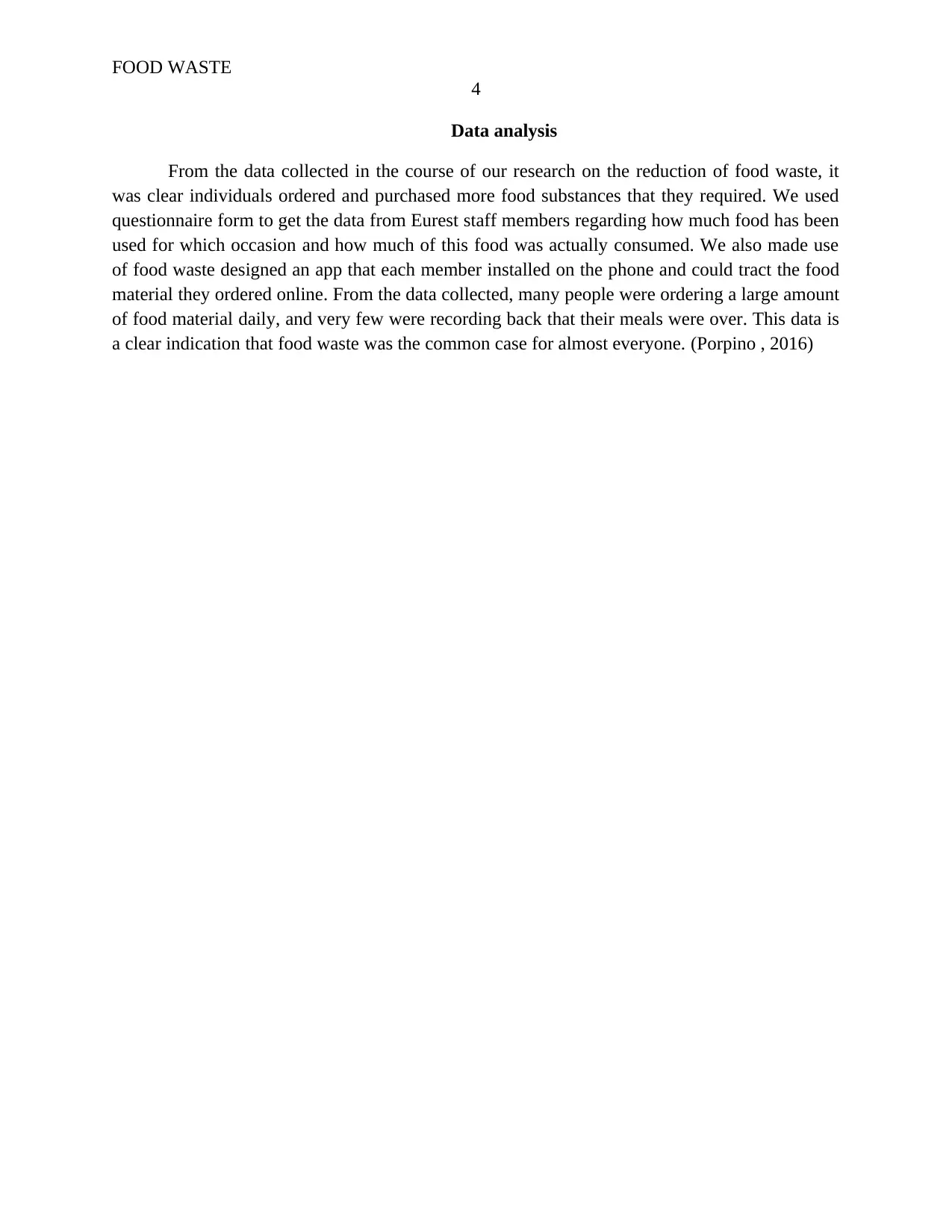
FOOD WASTE
4
Data analysis
From the data collected in the course of our research on the reduction of food waste, it
was clear individuals ordered and purchased more food substances that they required. We used
questionnaire form to get the data from Eurest staff members regarding how much food has been
used for which occasion and how much of this food was actually consumed. We also made use
of food waste designed an app that each member installed on the phone and could tract the food
material they ordered online. From the data collected, many people were ordering a large amount
of food material daily, and very few were recording back that their meals were over. This data is
a clear indication that food waste was the common case for almost everyone. (Porpino , 2016)
4
Data analysis
From the data collected in the course of our research on the reduction of food waste, it
was clear individuals ordered and purchased more food substances that they required. We used
questionnaire form to get the data from Eurest staff members regarding how much food has been
used for which occasion and how much of this food was actually consumed. We also made use
of food waste designed an app that each member installed on the phone and could tract the food
material they ordered online. From the data collected, many people were ordering a large amount
of food material daily, and very few were recording back that their meals were over. This data is
a clear indication that food waste was the common case for almost everyone. (Porpino , 2016)
Paraphrase This Document
Need a fresh take? Get an instant paraphrase of this document with our AI Paraphraser
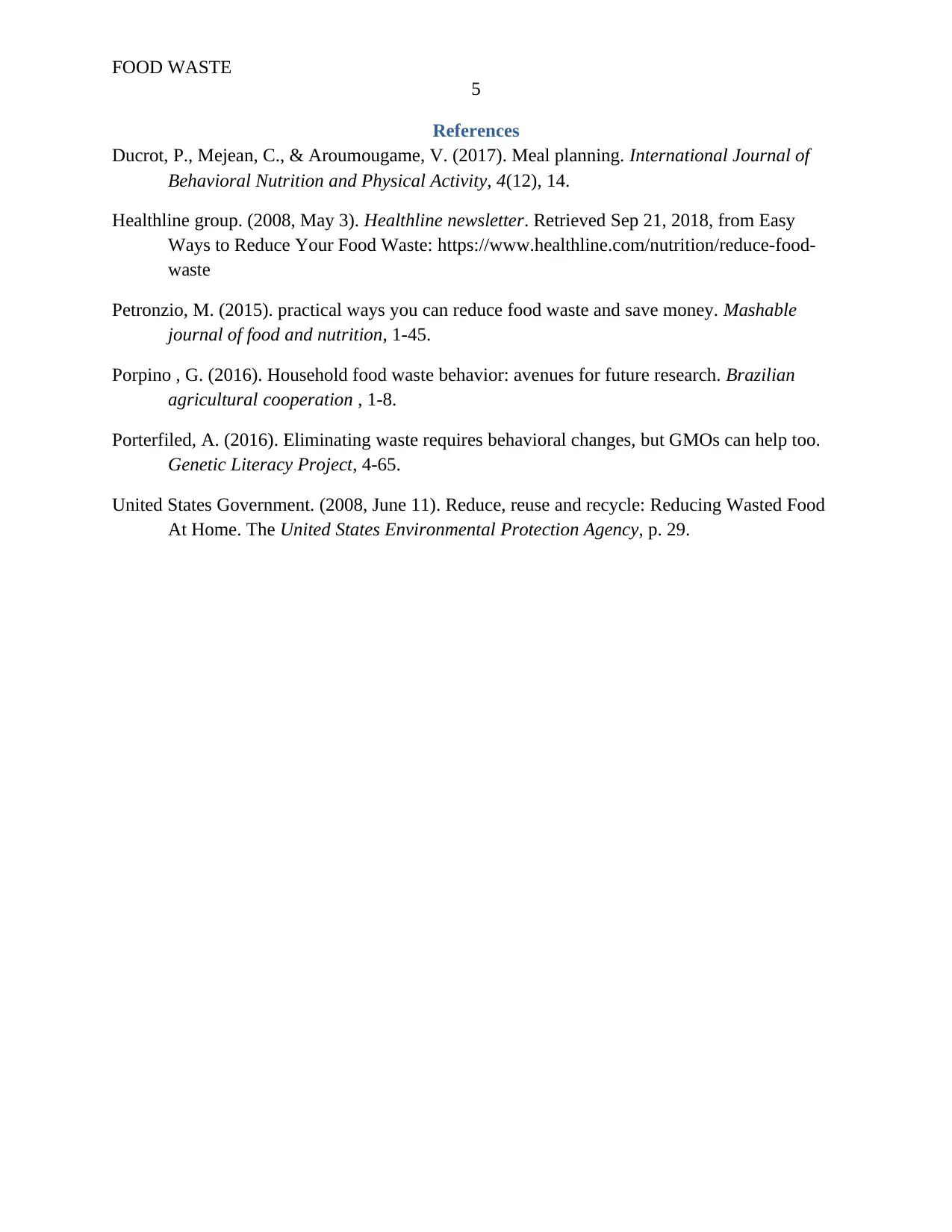
FOOD WASTE
5
References
Ducrot, P., Mejean, C., & Aroumougame, V. (2017). Meal planning. International Journal of
Behavioral Nutrition and Physical Activity, 4(12), 14.
Healthline group. (2008, May 3). Healthline newsletter. Retrieved Sep 21, 2018, from Easy
Ways to Reduce Your Food Waste: https://www.healthline.com/nutrition/reduce-food-
waste
Petronzio, M. (2015). practical ways you can reduce food waste and save money. Mashable
journal of food and nutrition, 1-45.
Porpino , G. (2016). Household food waste behavior: avenues for future research. Brazilian
agricultural cooperation , 1-8.
Porterfiled, A. (2016). Eliminating waste requires behavioral changes, but GMOs can help too.
Genetic Literacy Project, 4-65.
United States Government. (2008, June 11). Reduce, reuse and recycle: Reducing Wasted Food
At Home. The United States Environmental Protection Agency, p. 29.
5
References
Ducrot, P., Mejean, C., & Aroumougame, V. (2017). Meal planning. International Journal of
Behavioral Nutrition and Physical Activity, 4(12), 14.
Healthline group. (2008, May 3). Healthline newsletter. Retrieved Sep 21, 2018, from Easy
Ways to Reduce Your Food Waste: https://www.healthline.com/nutrition/reduce-food-
waste
Petronzio, M. (2015). practical ways you can reduce food waste and save money. Mashable
journal of food and nutrition, 1-45.
Porpino , G. (2016). Household food waste behavior: avenues for future research. Brazilian
agricultural cooperation , 1-8.
Porterfiled, A. (2016). Eliminating waste requires behavioral changes, but GMOs can help too.
Genetic Literacy Project, 4-65.
United States Government. (2008, June 11). Reduce, reuse and recycle: Reducing Wasted Food
At Home. The United States Environmental Protection Agency, p. 29.
1 out of 5
Related Documents
Your All-in-One AI-Powered Toolkit for Academic Success.
+13062052269
info@desklib.com
Available 24*7 on WhatsApp / Email
![[object Object]](/_next/static/media/star-bottom.7253800d.svg)
Unlock your academic potential
Copyright © 2020–2025 A2Z Services. All Rights Reserved. Developed and managed by ZUCOL.



